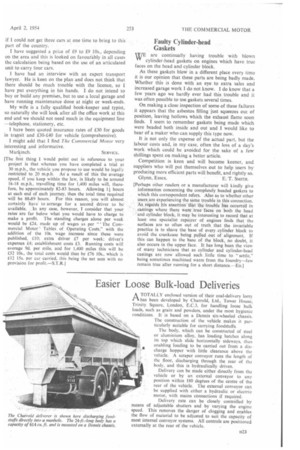Faulty Cylinder-head Gaskets
Page 63

If you've noticed an error in this article please click here to report it so we can fix it.
E are continually having trouble with blown cylinder-head gaskets on engines which have true faces on the head and cylinder block.
As these gaskets blow in a different place every time it is our opinion that these parts are being badly made. Whether this is done with an eye to extra sales and increased garage work I do not know. I do know that a few years ago we hardly ever had this trouble and it was often possible to use gaskets several times.
On making a close inspection of some of these failures it appears that the asbestos filling just squeezes out of position, leaving hollows which the exhaust flame soon finds. I seem to remember gaskets being made which were beaded both inside and out and I would like to hear of a maker who can supply this type now.
It is not only the expense of the actual part, but the labour costs and, in my case, often the loss of a day's work which could be avoided for the sake of a few shillings spent on making a better article.
Competition is keen and will become keener, and suppliers who will put themselves out to help users by producing more efficient parts will benefit, and rightly so.
Glynn, Essex. E. T. SMITH.
[Perhaps other readers or a manufacturer will kindly give information concerning the completely beaded gaskets to which this correspondent refers. Also as to whether other users are experiencing the same trouble in this connection. As regards his assertion 'drat the trouble has occurred in castings where there were Arne faces on both the head and cylinder block, it may be interesting to record that at least one specialist repairer of engines finds that the surfaces are so often out of truth that the invariable practice is to shave the base of every .cylinder block to avoid the crankcase being .pulled out of alignment. If this can happen to the base of the block, no doubt, it also occurs in the upper face. It has long been the view of many technicians that as cylinder and cylinder-head castings are now allowed such little time to " settle," being sometimes machined warm from the foundry—few remain true after running for a short distance.—En.]








































































































